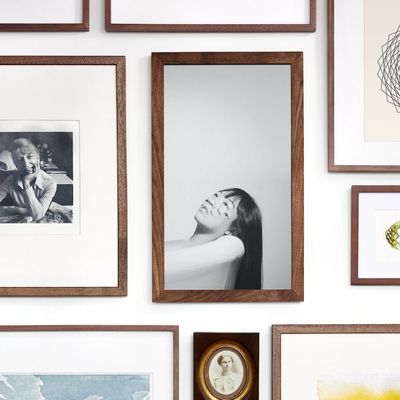
My desk, normally a rat’s nest of cords and empty Diet Coke cans, has gotten a serious upgrade lately. That’s because I’ve had Electric Objects’ EO2 sitting on it, a $299, 1080p, 23-inch digital art display I’ve set up to slowly cycle through classic and contemporary art, everything from van Gogh to Tumblr-esque GIF madness.
Electric Objects and the EO2 represent an attempt by its founder, Jake Levine, to democratize fine art, take it out of the gallery and into the home, and make it as ubiquitous as music or Netflix. It’s an admirable effort — get art seen by more people and remove the exclusivity that fuels so much of the current art scene.
The EO2, the second iteration of the company’s online digital frames, seeks to do that through a subscription service, Art Club, which finds interesting upcoming artists and makes their work available for the EO2. The setup and control are simple: Plug in the frame, register it with your phone, and start browsing art from your phone or computer. You get a free 30-day subscription to Art Club (which is $9.99 per month thereafter), which has over over 1,000 works by 200 different artists currently. Even if you don’t take the plunge on the Art Club, the Community section has over 30,000 images to browse.
There’s real fun to be had here. Discovery, whether by simply scrolling through the artist directory or seeing what’s popular among users, can lead you down all sorts of rabbit holes. Each piece has a “Similar Art” underneath, and it’s easy to hopscotch your way through works. You can also browse what other users have chosen to display on their EO2, and then haunt their picks to see how closely the rest of their taste matches up to your own. The Art Club also does rotating installations of sorts, compiling works by different artists around certain themes. Just a few hours in, I had already stumbled across artists like damp camp and Grace Blake that I never would have found otherwise. You can also set up playlists of certain works, and set how often to rotate through them — the type of thing you might do before a dinner party or just to have something to look at while working.
And, of course, because the EO2 is a digital display, it can show objects in motion. How much you’ll enjoy these will vary greatly depending on your personal taste — I found some of the subtler, more thoughtful motion effects to be fantastic, while the more frenetic video works came off like hyperactive screensavers, more eyesore than artwork. But the gems here are utterly unlike anything you could normally hang on your wall.
It’s not all perfect. The 1080p display looks fine a few feet away, but lean in close and you’ll spot pixels easily enough — the cost of a producing something with enough pixel density where that would simply disappear still remains too high. It also relies heavily on the art being high-resolution enough look crisp on the screen — some of the pieces available through Art Club, even non-moving images, looked surprisingly pixelated or with noticeable image artifacts. The EO2 9:16 aspect ratio makes for a particularly tall and narrow portrait screen. This means nearly all the classic pieces of art you can display are cropped to show off only certain sections — or have floating blank space at the top and bottom of the images. Artists selected for the Art Club know the dimensions they’ll be working with and most work well within them, but outside that you start to run into some issues.
There’s also the fact that if you want to hang this on a wall (and I think its natural place is on a wall, though Electric Objects also sells a stand so you can put it on a table or shelf), there will be a long cord running off it. Creative interior decorators can no doubt find ways to hide these wires, but it’s something to consider.
Finally, there are just some moments where the tech’s reach outstrips its grasp. The EO2 is great at showing vibrant oil paintings — the light from the LED screen makes the color in the classic oil paintings of Vermeer or van Gogh seem luminous. Other painters, like Gustav Klimt, with his heavy reliance on gold leaf, look washed-out on the EO2 — it would be better to buy a $20 print and frame that. Black-and-white photography suffers even more — LED screens simply can’t reproduce the inky blacks needed to create real depth and contrast, making classic photographs look overexposed. Again, a cheap print is, from a pure visual-fidelity standpoint, going to look better. (This could be alleviated with an OLED screen, but then you wouldn’t be able to snag one for $299, and would have other issues like screen burn in to worry about.)
But even a low-cost print costs a fair amount to frame (or the time, tools, and skill to make perfect miter joints), and once you’ve framed and hung something, that’s all it’ll ever be. The EO2 can be tens of thousands of different works of art, everything from classics to fascinating data visualizations. Our tastes, like everything else about us, shift over time. The EO2 is one of the few pieces of art you can hang on your wall that will shift with you.
A small note: If you buy something through some of our links, New York may get a small cut of the sale. That said, we don’t recommend things we wouldn’t buy ourselves.





























